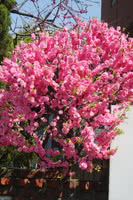Mon-Fri 9am - 5pm Mountain time
Black Elderberry vs Double Flowering Plum
Sambucus canadensis
Prunus triloba Multiplex
NOT AVAILABLE THIS SEASON - MIGHT RETURN
NOT AVAILABLE THIS SEASON - MIGHT RETURN
Black Elderberry is a deciduous shrub native to eastern North America. You can plant this shrub in moist areas and it will help stabilize your soil. You can also use it on rural properties anywhere you'd use a lilac.
Black Elderberries are considered to be partially self-pollinating. So while they will still produce some berries without cross-pollination, planting with another variety will increase yields. Consider planting with Ranch Elderberry or Bob Gordon Elderberry.
Warning: the seeds, stems, leaves, roots, and uncooked berries of the Black Elderberry are poisonous to humans when eaten in quantity. You should cook the berries to make them safe for human consumption.
With the Double Flowering Plum in your garden, you'll be the envy of your block. Not only is it a stunning visual, but it is one of the earliest spring bloomers. With its gorgeous double pink blooms, this Plum is irresistible to birds, butterflies, and neighbours alike.
Black Elderberry Quick Facts
Double Flowering Plum Quick Facts
Toxicity: leaves, stems, and uncooked berries are poisonous to humans

